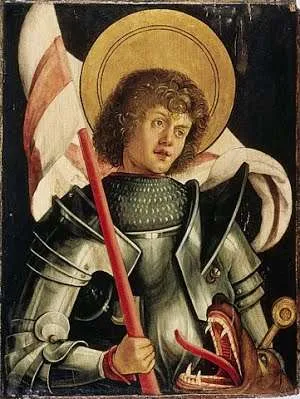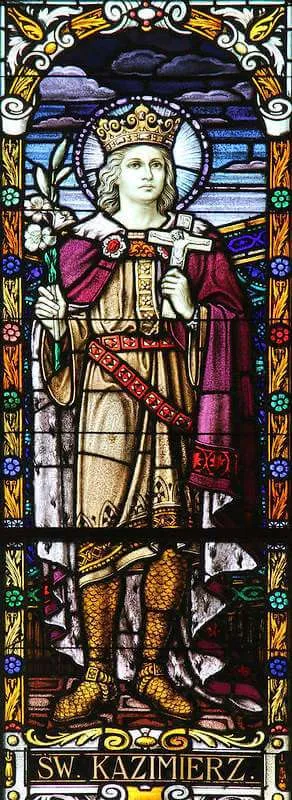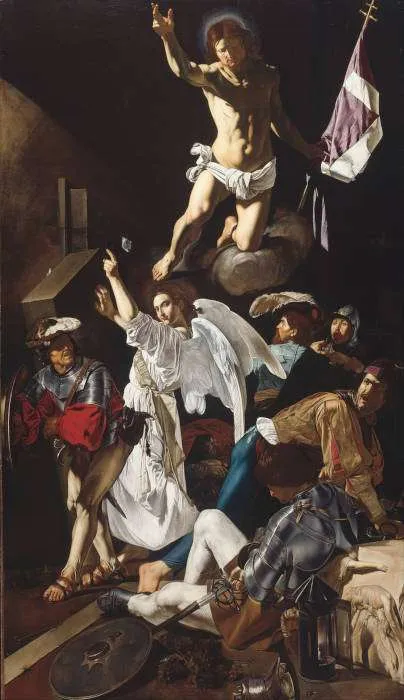Very little is known about Saint George, other than that he was martyred by the Roman Emperor Diocletian around the year 303 for refusing to renounce his Christian faith and offer sacrifice to the Roman gods. Eusebius, a fourth century bishop, stated that Constantine the Great, Roman Emperor from 306–337, dedicated a church to “a man of the highest distinction.” This unnamed man is believed to be Saint George. By the end of the fourth century, Saint George was revered throughout Palestine and the Eastern Byzantine Empire. By the fifth century, devotion to him spread to the Western Roman Empire. Over the centuries, he became the patron saint of more than a dozen countries, as well as cities and dioceses within many more. In the thirteenth century, Saint George appeared in the famous Golden Legend, a popular medieval devotional on the lives of the saints. In the fourteenth century, Saint George became known as one of the Fourteen Holy Helpers whose intercession was readily sought, especially during the Black Death, a European plague that took the lives of countless millions. Though the details of his life have been lost to history, his influence has been great and his legends have been prayerfully pondered far and wide. Unquestionably, he is one of the most venerated saints in history.
According to the eleventh-century Greek monk Symeon of Metaphrastes, Saint George was born to noble Christian parents in Cappadocia, modern-day Turkey. When his father died, George and his mother moved to Lydda, Palestine, located near modern-day Tel Aviv, Israel, where his mother had been born and where she inherited a large estate. George eventually joined the army of the Roman Emperor Diocletian and advanced to the rank of colonel.
Around the year 299, Diocletian participated in a pagan Roman religious ceremony in which he sought to predict the future. When it failed, Diocletian believed that Christians were to blame, so he began a process of purifying the empire by forcing his subjects to honor the Roman gods. In 303, Diocletian issued an edict with the aim of eradicating Christians across the empire. Churches were to be destroyed, Scripture burned, public worship forbidden, and Christians, especially those in the military, were forced to offer sacrifice to the Roman gods. Those who refused faced imprisonment or death.
When George heard about this edict, he seized a copy and tore it up and then personally confronted the emperor and chastised him for his cruelty. George went on to profess to the emperor that he was a Christian. He was immediately arrested and jailed, and the emperor attempted to convert him back to the pagan Roman gods. George refused. As a result, he endured one torture after another. One legend says he first had heavy blocks of stone placed upon his chest. Then he was tied to a wheel that, when spun, sliced his flesh with knives. He miraculously endured it all. The emperor then tried to entice George with promises of favors if he returned to the Roman gods. To this, the legend goes on, George responded to his jailer, “I despise your promises and do not fear your threats. The emperor’s power is of short duration, and his reign will soon end. It is better for you, to acknowledge the true God and to seek His kingdom.” The next day, George was led through the city and then beheaded. His witness was so powerful that many Roman pagans are said to have converted. One account even states that Empress Alexandra of Rome, possibly Diocletian’s wife, also converted and died a martyr as a result.
Saint George is the patron saint of soldiers in part because he was in the military. However, devotion to him exploded during the first Crusade when, in 1098, during the Battle of Antioch, a priest had a vision of Saint George telling him where to find the spear that pierced Christ’s Heart on the Cross. Once the Crusaders discovered the spear, they were encouraged and were led into battle with another priest leading the way with the spear. During the battle, the Crusaders were said to have had visions of three saint martyrs riding with them into battle: Saint George, Saint Mercurius, and Saint Demetrius.
Saint George’s popularity in England began when King Richard the Lionheart visited a church dedicated to Saint George on his way to help with the first Crusade. It is believed that he and his men had a vision of the saint, which encouraged them in their battle. About 250 years later, King Edward III named Saint George as the patron saint of England, referring to him as “the most invincible athlete of Christ, whose name and protection the English nation invoke as that of their patron, especially in war.”
One legend about Saint George has left him with the nickname “Saint George the Dragonslayer.” The Golden Legend relates that a fierce dragon lived in the province of Libya, in the town of Silene. The villagers used to feed it two sheep every day, but when the sheep failed to suffice, they selected one villager each day, along with a sheep. One day, the lot fell on the king’s own daughter, and, as she went out to give herself to the dragon, Saint George rode in on horseback, slew the dragon, and converted the entire town to the Catholic faith, with about 15,000 men receiving baptism.
Though the story is clearly fictional, it has provided inspiration for generations, especially to soldiers in war. Some have interpreted the dragon in the story as the devil and have seen Saint George’s slaying of the dragon as an indication of the power of his intercession. The legend, then, can be seen as a parable, meant to encourage Saint George’s intercession when confronting the worst of evils.
As we honor Saint George, as so many others have done throughout history, don’t hesitate to call upon his intercession. If you struggle with any “dragon” in your life—any evil, or suffering that seems unbearable—then especially turn to this greatly venerated saint, and trust that he will intercede for you, just as he has throughout history.
Source: https://mycatholic.life/saints/saints-of-the-liturgical-year/april-23-saint-george-martyr/








